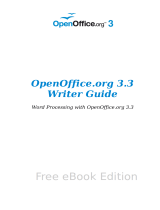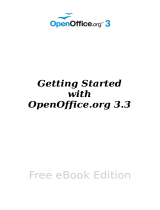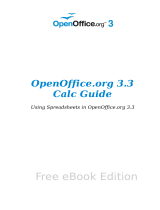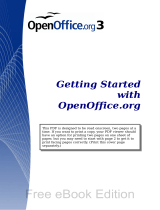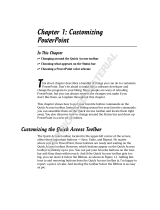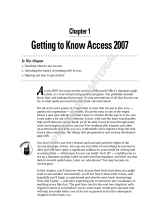Page is loading ...

Getting Started
with
OpenOffice.org 3
This PDF is designed to be read onscreen, two pages at a
time. If you want to print a copy, your PDF viewer should
have an option for printing two pages on one sheet of
paper, but you may need to start with page 2 to get it to
print facing pages correctly. (Print this cover page
separately.)
Alternatively, you can download a free PDF of the printed
edition or buy a low-cost printed copy from
http://stores.lulu.com/opendocument. You can also
download an editable (.odt) version of this book from
http://oooauthors.org/en/authors/userguide3/published/

Copyright
This document is Copyright © 2005–2008 by its contributors as listed
in the section titled Authors. You may distribute it and/or modify it
under the terms of either the GNU General Public License, version 3 or
later, or the Creative Commons Attribution License, version 3.0 or
later. All trademarks within this guide belong to their legitimate
owners.
Authors
Thomas Astleitner Richard Barnes
Agnes Belzunce Daniel Carrera
Richard Detwiler Spencer E. Harpe
Regina Henschel Peter Hillier-Brook
John Kane Stefan A. Keel
Michael Kotsarinis Peter Kupfer
Ian Laurenson Dan Lewis
Alan Madden Michel Pinquier
Andrew Pitonyak Carol Roberts
Iain Roberts Gary Schnabl
Robert Scott Janet M. Swisher
Barbara M. Tobias Jean Hollis Weber
Linda Worthington Michele Zarri
Feedback
Please direct any comments or suggestions about this document to:
Publication date and software version
Published 26 October 2008. Based on OpenOffice.org 3.0.
You can download
an editable version of this document from
http://oooauthors.org/en/authors/userguide3/published/

Contents
Chapter 1
Introducing OpenOffice.org.......................................................9
What is OpenOffice.org?...................................................................10
The advantages of OpenOffice.org....................................................12
Minimum requirements....................................................................13
How to get the software....................................................................13
How to install the software...............................................................14
How to get help.................................................................................14
Extensions and add-ons....................................................................16
Starting OpenOffice.org....................................................................16
Parts of the main window..................................................................20
Starting a new document..................................................................24
Opening an existing document..........................................................25
Saving documents.............................................................................25
Renaming and deleting files..............................................................26
Using the Open and Save As dialogs.................................................27
Using the Navigator..........................................................................28
Closing a document..........................................................................30
Closing OpenOffice.org.....................................................................30
Chapter 2
Setting up OpenOffice.org........................................................31
Choosing options for all of OOo........................................................32
Choosing options for loading and saving documents........................47
Choosing language settings..............................................................52
Choosing Internet options.................................................................55
Controlling OOo’s AutoCorrect functions.........................................55
Chapter 3
Using Styles and Templates......................................................57
What is a template?..........................................................................58
What are styles?................................................................................58
Applying styles..................................................................................60
Modifying styles................................................................................62
Creating new (custom) styles............................................................64
Copying and moving styles...............................................................65
Getting Started with OpenOffice.org 3 3

Deleting styles..................................................................................68
Using a template to create a document............................................68
Creating a template..........................................................................69
Editing a template.............................................................................72
Adding templates using the Extension Manager...............................73
Setting a default template................................................................74
Associating a document with a different template............................75
Organizing templates........................................................................76
Examples of style use........................................................................79
Chapter 4
Getting Started with Writer......................................................81
What is Writer?.................................................................................82
The Writer interface..........................................................................82
Working with documents..................................................................86
Working with text..............................................................................87
Formatting text.................................................................................97
Undoing and redoing changes........................................................102
Formatting pages............................................................................103
Adding notes to a document...........................................................108
Creating a table of contents............................................................110
Creating indexes and bibliographies...............................................111
Working with graphics....................................................................111
Printing from Writer.......................................................................111
Sending a fax using Writer..............................................................120
Tracking changes to a document....................................................121
Using mail merge............................................................................121
Using master documents................................................................122
Creating fill-in forms.......................................................................122
Using fields.....................................................................................122
Using cross-references...................................................................123
Using bookmarks............................................................................124
Chapter 5
Getting Started with Calc.......................................................125
What is Calc?..................................................................................126
Spreadsheets, sheets and cells.......................................................126
Parts of the main Calc window........................................................126
4 Getting Started with OpenOffice.org 3

Starting new spreadsheets.............................................................130
Opening existing spreadsheets.......................................................131
Saving spreadsheets.......................................................................131
Navigating within spreadsheets......................................................132
Selecting items in a sheet or spreadsheet......................................135
Working with columns and rows.....................................................138
Working with sheets........................................................................140
Viewing Calc...................................................................................141
Entering data using the keyboard...................................................145
Speeding up data entry...................................................................146
Editing data....................................................................................150
Formatting data..............................................................................151
Autoformatting cells and sheets......................................................156
Formatting spreadsheets using themes..........................................157
Hiding and showing data................................................................157
Sorting records...............................................................................160
Printing...........................................................................................161
Chapter 6
Getting Started with Impress.................................................170
What is Impress?.............................................................................171
Parts of the main Impress window..................................................171
Working with views.........................................................................175
Creating a new presentation...........................................................180
Formatting a presentation..............................................................185
Slide masters and styles.................................................................189
Working with slide masters.............................................................190
Adding and formatting text.............................................................194
Creating tables...............................................................................199
Adding graphics, spreadsheets, charts, and other objects..............200
Setting up the slide show................................................................201
Running the slide show...................................................................202
Chapter 7
Getting Started with Draw......................................................203
What is Draw?.................................................................................204
The Draw workspace......................................................................204
Positioning objects with snap functions..........................................211
Getting Started with OpenOffice.org 3 5

Positioning objects with helper lines...............................................214
The basic drawing shapes...............................................................214
Drawing geometric shapes.............................................................220
Selection modes..............................................................................222
Selecting objects.............................................................................223
Moving and dynamically adjusting an object’s size.........................225
Editing objects................................................................................227
Using styles.....................................................................................230
Special effects.................................................................................230
Combining multiple objects............................................................233
Aids for positioning objects.............................................................234
Editing pictures..............................................................................235
Working with 3D objects.................................................................235
Inserting pictures from other sources.............................................235
Exchanging objects with other programs.......................................236
Chapter 8
Getting Started with Base.......................................................237
Introduction....................................................................................238
Planning a database........................................................................239
Creating a new database................................................................241
Creating database tables................................................................242
Defining relationships.....................................................................253
Creating a database form...............................................................256
Accessing other data sources..........................................................277
Using data sources in OpenOffice.org............................................279
Entering data in a form...................................................................285
Creating queries.............................................................................288
Creating reports..............................................................................298
Chapter 9
Getting Started with Math.....................................................309
What is Math?.................................................................................310
Entering a formula..........................................................................311
Customizations................................................................................316
Formula layout................................................................................319
Common problem areas..................................................................320
6 Getting Started with OpenOffice.org 3

Chapter 10
Printing, Exporting, and E-mailing........................................323
Introduction....................................................................................324
Quick printing.................................................................................324
Controlling printing........................................................................324
Exporting to PDF............................................................................325
Exporting to other formats.............................................................331
E-mailing documents......................................................................332
Digital signing of documents..........................................................335
Chapter 11
Graphics, the Gallery, and Fontwork......................................337
Introduction....................................................................................338
Inserting an image from a file.........................................................338
Inserting images from a graphics program.....................................340
Inserting images using a scanner...................................................341
Modifying and positioning graphics................................................341
Using the OpenOffice.org Gallery...................................................341
Managing the Gallery.....................................................................343
What is Fontwork?..........................................................................346
The Fontwork toolbars....................................................................346
Creating a Fontwork object.............................................................346
Editing a Fontwork object...............................................................348
Moving and resizing Fontwork objects...........................................353
Chapter 12
Creating Web Pages................................................................354
Introduction....................................................................................355
Inserting hyperlinks........................................................................355
Saving Writer documents as web pages..........................................357
Saving Calc spreadsheets as web pages.........................................362
Saving Impress presentations as web pages...................................362
Saving Draw documents as web pages...........................................366
Chapter 13
Getting Started with Macros..................................................367
Your first macro..............................................................................368
Creating a macro............................................................................373
Sometimes the macro recorder fails...............................................377
Getting Started with OpenOffice.org 3 7

Macro organization.........................................................................379
How to run a macro........................................................................384
Extensions.......................................................................................389
Writing macros without the recorder..............................................390
Finding more information...............................................................391
Chapter 14
Customizing OpenOffice.org..................................................393
Introduction....................................................................................394
Customizing menu content.............................................................394
Customizing toolbars......................................................................398
Assigning shortcut keys..................................................................402
Assigning macros to events.............................................................405
Adding functionality with extensions..............................................405
Using extensions.............................................................................406
Appendix A
Keyboard Shortcuts................................................................409
Introduction....................................................................................410
Function key shortcuts....................................................................411
General shortcut keys for OpenOffice.org......................................411
Shortcut keys in the Gallery............................................................413
Selecting rows and columns in a database table (opened by F4)....414
Shortcut keys for drawing objects..................................................414
Appendix B
Background Information.......................................................416
Introduction....................................................................................417
A short history of OpenOffice.org...................................................417
The OpenOffice.org community......................................................417
How is OpenOffice.org licensed?....................................................418
What is “open source”?...................................................................418
What is OpenDocument?.................................................................419
File formats OOo can open.............................................................419
File formats OOo can save to..........................................................421
Frequently asked questions............................................................423
Index.........................................................................................426
8 Getting Started with OpenOffice.org 3

Chapter 1
Introducing OpenOffice.org

What is OpenOffice.org?
OpenOffice.org (OOo) is both a
software product
and a
community of
volunteers
who produce and support the software.
Note
Because someone else owns the trademark
OpenOffice
, the
correct name for both the open-source project and its software is
OpenOffice.org
.
The OpenOffice.org software is a freely available, full-featured office
suite.
OOo 3 is a major upgrade of an already feature-rich office suite. If you
have used previous versions of OOo, please look over the new features
list on the OOo wiki.
OOo’s native file format is OpenDocument, an open standard format
that is being adopted by governments worldwide as a required file
format for publishing and accepting documents. OOo can also open
and save documents in many other formats, including those used by
several versions of Microsoft Office.
OOo includes the following components.
Writer (word processor)
Writer is a feature-rich tool for creating letters, books, reports,
newsletters, brochures, and other documents. You can insert graphics
and objects from other components into Writer documents. Writer can
export files to HTML, XHTML, XML, Adobe’s Portable Document
Format (PDF), and several versions of Microsoft Word files. It also
connects to your email client.
Calc (spreadsheet)
Calc has all of the advanced analysis, charting and decision-making
features expected from a high-end spreadsheet. It includes over 300
functions for financial, statistical, and mathematical operations, among
others. The Scenario Manager provides “what if” analyses. Calc
generates 2-D and 3-D charts, which can be integrated into other OOo
documents. You can also open and work with Microsoft Excel
workbooks and save them in Excel format. Calc can export
spreadsheets to Adobe’s PDF and to HTML.
10 Getting Started with OpenOffice.org 3

Impress (presentations)
Impress provides all the common multimedia presentation tools, such
as special effects, animation, and drawing tools. It is integrated with
the advanced graphics capabilities of OOo’s Draw and Math
components. Slideshows can be further enhanced with Fontwork’s
special effects text, as well as sound and video clips. Impress is
compatible with Microsoft’s PowerPoint file format and can also save
your work in numerous graphics formats, including Macromedia Flash
(SWF).
Draw (vector graphics)
Draw is a vector drawing tool that can produce everything from simple
diagrams or flowcharts to 3-D artwork. Its Smart Connectors feature
allows you to define your own connection points. You can use Draw to
create drawings for use in any of OOo’s other components, and you can
create your own clipart and add it to the Gallery. Draw can import
graphics from many common formats and save them in over 20 formats
including PNG, HTML, PDF, and Flash.
Base (database)
Base provides tools for day-to-day database work within a simple
interface. It can create and edit forms, reports, queries, tables, views,
and relations, so that managing a connected database is much the
same as in other popular database applications. Base provides many
new features, such as the ability to analyze and edit relationships from
a diagram view. Base incorporates HSQLDB as its default relational
database engine. It can also use dBASE, Microsoft Access, MySQL, or
Oracle, or any ODBC- or JDBC-compliant database. Base also provides
support for a subset of ANSI-92 SQL.
Math (formula editor)
Math is OOo’s formula or equation editor. You can use it to create
complex equations that include symbols or characters not available in
standard font sets. While it is most commonly used to create formulas
in other documents, such as Writer and Impress files, Math can also
work as a stand-alone tool. You can save formulas in the standard
Mathematical Markup Language (MathML) format for inclusion in
webpages and other documents not created by OOo.
Chapter 1 Introducing OpenOffice.org 11

The advantages of OpenOffice.org
Here are some of the advantages of OpenOffice.org over other office
suites:
• No licensing fees. OOo is free for anyone to use and distribute at
no cost. Many features that are available as extra cost add-ins in
other office suites (like PDF export) are free with OOo. There are
no hidden charges now or in the future.
• Open source. You can distribute, copy, and modify the software
as much as you wish, in accordance with either of OOo’s Open
Source licenses.
• Cross-platform. OOo3 runs on several hardware architectures
and under multiple operating systems, such as Microsoft
Windows, Mac OS X, Linux, and Sun Solaris.
• Extensive language support. OOo’s user interface is available
in over 40 languages, and the OOo project provides spelling,
hyphenation, and thesaurus dictionaries in over 70 languages and
dialects. OOo also provides support for both Complex Text Layout
(CTL) and Right to Left (RTL) layout languages (such as Hindi,
Hebrew, and Arabic).
• Consistent user interface. All the components have a similar
“look and feel,” making them easy to use and master.
• Integration. The components of OpenOffice.org are well
integrated with one another.
– All the components share a common spelling checker and
other tools, which are used consistently across the suite. For
example, the drawing tools available in Writer are also found
in Calc, with similar but enhanced versions in Impress and
Draw.
– You do not need to know which application was used to create
a particular file (for example, you can open a Draw file from
Writer).
• Granularity. Usually, if you change an option, it affects all
components. However, OOo options can be set at a component
level or even document level.
• File compatibility. In addition to its native OpenDocument
formats, OOo includes PDF and Flash export capabilities, as well
as support for opening and saving files in many common formats
including Microsoft Office, HTML, XML, WordPerfect, and Lotus
123 formats. New in OOo3 (using an extension): the ability to
import and edit some PDF files.
12 Getting Started with OpenOffice.org 3

• No vendor lock-in. OOo3 uses OpenDocument, an XML
(eXtensible Markup Language) file format developed as an
industry standard by OASIS (Organization for the Advancement of
Structured Information Standards). These files can easily be
unzipped and read by any text editor, and their framework is open
and published.
• You have a voice. Enhancements, software fixes, and release
dates are community-driven. You can join the community and
affect the course of the product you use.
You can read more about OpenOffice.org, its mission, history, licensing,
and other organizational information on the OpenOffice.org website.
Minimum requirements
OpenOffice.org 3 requires one of the following operating systems:
• Microsoft Windows 98, Windows ME, Windows 2000 (Service
Pack 2 or higher), Windows XP, Windows 2003, or Windows Vista
• GNU/Linux Kernel version 2.2.13 and glibc 2.2.0 or newer
• Mac OS X 10.4.x, X11 required; Mac OS X 10.5+ without X11
• Solaris version 8 or higher
Some OpenOffice.org features (wizards and the HSQLDB database
engine) require that the Java Runtime Environment (JRE) be installed
on your computer. Although OOo will work fine without Java support,
some features will not be available. You can download OOo with or
without JRE included. If you have a slow machine and do not often
need the features requiring JRE, you can try to disable it to speed up
the loading of the program.
For a more detailed (and up-to-date) listing of requirements, see
http://www.openoffice.org/dev_docs/source/sys_reqs_30.html.
How to get the software
Many new computers come with OpenOffice.org installed. In addition,
most Linux distributions, such as Ubuntu, include OpenOffice.org.
If you need to install it yourself, it’s very easy to do. You can download
the OpenOffice.org installation package from the project’s home page
or by using a Peer to Peer client such as BitTorrent. Instructions for
BitTorrent are here.
The installation package is approximately 150MB. People with slow
Internet connections may prefer to purchase a copy on a CD or DVD
Chapter 1 Introducing OpenOffice.org 13

from a third-party distributor. The project maintains a list of
distributors, but the distributors are not connected with, nor endorsed
by, OpenOffice.org.
How to install the software
Information on installing and setting up OpenOffice.org on the various
supported operating systems is given here:
http://download.openoffice.org/ common/instructions.html
You can also download the more detailed
Setup Guide
(in several
languages) from http://documentation.
openoffice.org/setup_guide2/index.html
How to get help
This book and the other OOo user guides and help and user support
systems assume that you are familiar with your computer and basic
functions such as starting a program, opening and saving files.
Help system
OOo comes with an extensive Help system. This is your first line of
support for using OOo.
To display the full Help system, press
F1
or select OpenOffice.org
Help from the Help menu. In addition, you can choose whether to
activate tooltips, extended tips, and the Help Agent (using Tools >
Options > General).
If tooltips are enabled, place the mouse pointer over any of the icons to
see a small box (“tooltip”) with a brief explanation of the icon’s
function. For a more detailed explanation, select Help > What's This?
and hold the pointer over the icon.
Free online support
The OpenOffice.org community not only develops software, but
provides free, volunteer-based support. Users of OOo can get
comprehensive online support from community venues such as
newsgroups, forums, or mailing lists. There are also numerous
websites run by users that offer free tips and tutorials.
14 Getting Started with OpenOffice.org 3

Free OpenOffice.org support
Users Mailing List
Free community support provided by a network of
hundreds of experienced users. You must be
subscribed to post messages. To subscribe, send a
blank email to
List archives are here:
http://www.openoffice.org/servlets/ SummarizeList?
listName=users
Documentation
Project
Templates, user guides, how-tos, and other
documentation. http://documentation.openoffice.org/
See also the Documentation wiki,
http://wiki.services.openoffice.org/
wiki/Documentation
Native Language
Project
Information, resources, and mail lists in your
language.
http://projects.openoffice.org/native-lang.html
Mac Support
Support for installing and using OOo on Mac OS X.
http://porting.openoffice.org/mac/index.html
OpenOffice.org
Community Forum
Extensive discussion forum for OpenOffice.org issues
from setup to advanced programming features.
http://user.services.openoffice.org/en/forum/
OpenOffice.org
Macro Information
Andrew Pitonyak, the author of
OpenOffice.org
Macros Explained
, maintains this site which provides
extensive documentation on OOo's macro capability.
Many good referral links are also provided:
http://www.pitonyak.org/oo.php
Read more about the support options for OOo at
http://support.openoffice.org/index.html
Paid support and training
Alternatively, you can pay for support services. Service contracts can
be purchased from a vendor or consulting firm specializing in
OpenOffice.org.
OOo is supported by Sun Microsystems, Inc. under the Sun Software
Support program, which includes two levels of support that cover
extended business hours or around-the-clock service for mission-
critical deployments.
Chapter 1 Introducing OpenOffice.org 15

A list of independent consultants and the services they offer, listed
alphabetically by region and then by country, is provided on the
OpenOffice.org website.
Extensions and add-ons
Several websites provide extensions and add-ons to enhance
OpenOffice.org. The following table lists a few of these websites. See
Chapter 14 (Customizing OpenOffice.org) for more information.
Free OOo templates, artwork, addons, and other resources
OpenOffice.org
Extensions
The official repository for extensions to OOo.
Most are free, but some are not.
http://extensions.services.openoffice.org/
OOExtras
Provides templates, samples, and macros in
several languages.
http://ooextras.sourceforge.net/
OOoMacros
A repository for OOo macros and add-ons and
documentation about writing macros or
extending OOo. http://www.ooomacros.org/
Open Clip Art Library
An archive of clip art that can be used for free
for any use. http://www.openclipart.org/
Starting OpenOffice.org
The most common way to launch any component of OOo is by using the
system menu, the standard menu from which most applications are
started. On Windows, it is called the Start menu. On GNOME, it is
called the Applications menu. On KDE it is identified by the KDE logo.
On Mac OS X, it is the Applications menu.
When OOo was installed on your computer, in most cases a menu entry
for each component was added to your system menu. (If you are using
a Mac, see note below.) The exact name and location of these menu
entries depends on the operating system and graphical user interface.
Note for Mac users
You should see the OpenOffice.org icon in the Applications folder.
When you double-click this icon, a text document opens in Writer. To
16 Getting Started with OpenOffice.org 3

open the other components (Draw, Calc, Impress, Base), go to the File
menu of the Writer window and select the component you want.
OOo does not automatically put a shortcut icon on the desktop, but you
can add one if you wish. If you don’t know how to add shortcut icons
for launching programs, please consult the help for your operating
system.
Starting from an existing document
You can start OOo by double-clicking the filename of an OOo document
in a file manager such as Windows Explorer. The appropriate
component of OOo will start and the document will be loaded.
Note for Windows users
If you have associated Microsoft Office file types with OOo, then when
you double-click on a *.doc (Word) file, it opens in Writer; *.xls (Excel)
files open in Calc, and *.ppt (Powerpoint) files open in Impress.
If you did not associate the file types, then when you double-click on a
Microsoft Word document, it opens in Microsoft Word (if Word is
installed on your computer), Excel files open in Excel, and Powerpoint
files open in Powerpoint.
You can use another method to open Microsoft Office files in OOo and
save in those formats from OOo. See “Opening an existing document”
on page 25 for more information.
Using the Quickstarter under Windows
The Quickstarter is an icon that is placed in the Windows system tray
during system startup. It indicates that OpenOffice.org has been
loaded and is ready to use. (The Quickstarter loads library .DLL files
required by OOo, thus shortening the startup time for OOo components
by about half.) If the Quickstarter is disabled, see “Reactivating the
Quickstarter” if you want to enable it.
Using the Quickstarter icon
Right-click the Quickstarter icon in the system tray to open a pop-up
menu from which you can open a new document, open the Templates
and Documents dialog, or choose an existing document to open. You
can also double-click the Quickstarter icon to display the Templates
and Documents dialog.
Chapter 1 Introducing OpenOffice.org 17

Figure 1: Quickstarter popup menu
Disabling the Quickstarter
To close the Quickstarter, right-click on the icon in the system tray, and
then click Exit Quickstarter on the pop-up menu. The next time the
computer is restarted, the Quickstarter will be loaded again.
To prevent OpenOffice.org from loading during system startup,
deselect the Load OpenOffice.org during system start-up item on
the pop-up menu. You might want to do this if your computer has
insufficient memory, for example.
Reactivating the Quickstarter
If the Quickstarter has been disabled, you can reactivate it by selecting
the Load OpenOffice.org during system start-up checkbox in Tools
> Options > OpenOffice.org > Memory.
Using the Quickstarter in Linux
Some installations of OpenOffice.org under Linux have a Quickstarter
that looks and acts like the one described above for Windows (the
checkbox on the Memory page is labeled Enable systray
quickstarter).
Preloading OOo under Linux/KDE
In Linux/KDE, you can use KDocker to have OOo loaded and ready for
use at startup. KDocker is not part of OOo; it is a generic “systray app
docker” that is helpful if you open OOo often.
18 Getting Started with OpenOffice.org 3

Starting from the command line
You may want to start OOo from the command line (using the keyboard
instead of the mouse). Why? Well, by using the command line, you have
more control over what happens when OOo is started. For example,
using the command line, you can tell Writer to load a document and
print it immediately, or to start without showing the splash screen.
Note
Most users will never need to do this.
There is more than one way to start OOo from the command line,
depending on whether you have installed a customized version or the
standard download from the OOo website.
If you installed using the download on the OOo website, you can start
Writer by typing at the command line:
soffice -writer
or
swriter
Writer will start and create a new document. Likewise, you can start
other OOo components from the command line:
Type of document Component Command-line option
Text Writer
-writer
Spreadsheet Calc
-calc
Drawing Draw
-draw
Presentation Impress
-impress
Formula Math
-math
Web page Writer
-web
To see a list of options you can use when starting Writer at the
command line, type:
soffice -?
Below is a list of some of the more popular options.
Chapter 1 Introducing OpenOffice.org 19

Option Description
-help
Get a complete list of options.
-nologo
Do not show the startup screen.
-show <odp-file>
Start presentation immediately.
-view <documents ...>
Open documents in viewer (read-only) mode.
-minimized
Start OOo minimized.
-norestore
Suppress restart/restore after fatal errors.
-invisible
No startup screen, no default document and
no UI. This is useful for third-party
applications that use functionality provided
by OOo.
If you have a customized version of OOo (such as the one provided by
Linux Mandrake or Gentoo), you can start Writer by typing at the
command line:
oowriter
Note
Although the command syntax differs, the effect is identical: it
starts OOo with an empty Writer document.
Parts of the main window
The main window is similar in each component of OOo, although some
details vary. See the component chapters in this book for descriptions
of those details.
Common features include the menu bar, standard toolbar, and
formatting toolbar at the top of the window and the status bar at the
bottom.
Menu bar
The
Menu bar
is located across the top of the screen, just below the
Title bar. When you choose one of the menus, a submenu drops down
to show commands.
• File contains commands that apply to the entire document such
as Open, Save, and Export as PDF.
• Edit contains commands for editing the document such as Undo
and Find & Replace. It also contains commands to cut, copy and
paste selected parts of your document.
20 Getting Started with OpenOffice.org 3
/
